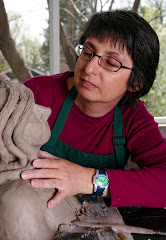Saturday, July 28, 2012
New Website for Out of the Fire Clay Sculpture Studio!
Hope this finds you well!
I've been off the radar for some time, but things have been happening behind the scenes.
For now, I'd like to announce the launch of my new website! My friend, Steven Durland, who is a great website designer, got me started, but there is a lot to learn about the process. (If you knew how small is my aptitude for this sort of thing and could see me at the computer now, you would be proud!)
At this point, I am still tweaking and have a lot to learn, but would love it if you could take a moment and check it out. You will find images of my own art and information on classes and happenings at the studio, as well as my artist-in-the-schools programs.
To go there, please click on "Out of the Fire," below, or at the top of this post:
The url is: http://cindybilesart.com
There is also a blog page there. Hoping to post more often and to do a better job of keeping in touch.
Please let me know if you see any problems or have any suggestions. Your feedback is most welcome!
Thank you!
Wednesday, May 9, 2012
Perrin and Jenni
Jenni and Perrin recently visited the studio and created these "Critters," as Perrin calls them.
Perrin working on an awesome beetle
Thursday, September 1, 2011
The Chameleon Contest! And the Winner is....

Friday, August 5, 2011
Can You Say, "Camouflage"?
Saturday, July 9, 2011
Name that Chameleon, Win a Class for Two!

Name Me!
When I chose this photo of a happy chameleon for my postcards for teaching clay sculpture classes, I had no idea how popular s/he would become. People of all ages have remarked that they picked up the postcard because of his (her?) great expression.
Even I still smile when I look at the photo.
Well, it’s time for this joyful Spokeslizard to have a name. Please send me your best suggestions and the author of the name chosen will win a 2-hour sculpture class for two people (includes clay and one firing) at Out of the Fire Sculpture Studio, in Saxapahaw, NC.
Anyone may enter! E-mail your entries to cbiles@triad.rr.com, or find the studio on Facebook: Out of the Fire Clay Sculpture by Cindy Biles. Deadline to enter is August 31, 2011. I'll post the winning name on Facebook and here in September.
Tuesday, June 28, 2011
Summer Fun!

Just finished Summer Fun, in time for the new show at the Saxapahaw Artists Gallery, in Saxapahaw, North Carolina. Members of this cooperative gallery are the featured artists for the month of July. We'll have an opening reception on Friday, July 1, from 6-9PM. There will be wonderful art, food and drink, music, conversation, good times. Hope to see you there!
Friday, June 10, 2011
Mason Stains, Demystified - an article by Jennifer Hoolihan at Highwater Clay
Ceramic Stain Act One
by Jennifer Hoolihan |
On your visits to Highwater Clays, you might have noticed all the brightly colored bags of powder neatly lined up in the stain aisle. Perhaps you were beguiled by the visual display but wondered, what are these? Good question! Read on, and we will provide a little clarity on the wide world of ceramic stains in part one of our tech tip stain series. |
|








